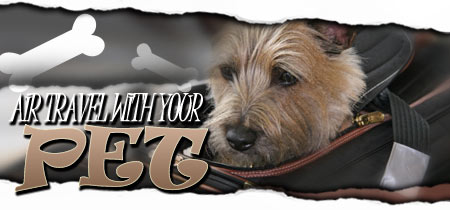
Safety Tips for Air Travel with Your Pet
 |
Make
sure to carry a photo of your pet with you while traveling by air, just in case
your pet is lost. |
If
you must transport your pet by air, your first decision is whether you can take
him or her on board with you, which is by far the best option. If your pet is
a cat or small dog, most airlines will allow you to take the animal on board for
an additional fee. To find out about this option, call the airline. Most airlines
provide information about transporting pets with them.
When
you contact the airline, find answers to these questions:
Does
the airline allow you to take your pet on board with you?
-
If that option
isn't available to you, does the airline have any restrictions on transporting
your pet as cargo?
-
Does
the airline have any special pet health and immunization requirements?
-
Does
the airline require a specific type of carrier? Most airlines will accept either
hard-sided carriers or soft-sided carriers, which may be more comfortable for
your pet, but only certain brands of soft-sided carriers are acceptable to certain
airlines.
If
your pet must travel in the cargo hold, you can increase the chances of a safe
flight for your pet by following these tips:
-
Use
direct flights. You will avoid the mistakes that occur during airline transfers
and possible delays in getting your pet off the plane.
-
Always
travel on the same flight as your pet. Ask the airline if you can watch your pet
being loaded and unloaded into the cargo hold.
-
When
you board the plane, notify the captain and at least one flight attendant that
your pet is traveling in the cargo hold. If the captain knows that pets are on
board, he or she may take special precautions.
-
Do
not ship pug-nosed dogs or cats such as Pekingese, Chow Chows, and Persians in
the cargo hold. These breeds have short nasal passages that leave them vulnerable
to oxygen deprivation and heat stroke in cargo holds.
-
If
traveling during the summer or winter months, choose flights that will accommodate
the temperature extremes: Early morning or late evening flights are better in
the summer; afternoon flights are better in the winter.
-
Fit
your pet with with a collar that can't get caught in carrier doors. Affix two
pieces of identification on the collar—a permanent ID with your name and
home address and telephone number and a temporary travel ID with the address and
telephone number where you or a contact person can be reached.
-
Affix
a travel label to the carrier with your name, permanent address and telephone
number, final destination, and where you or a contact person can be reached as
soon as the flight arrives.
-
Make
sure that your pet's nails have been clipped to protect against their hooking
in the carrier's door, holes, and other crevices.
-
Give
your pet at least a month before your flight to become familiar with the travel
carrier. This will minimize his or her stress during travel.
-
Do
not give your pet tranquilizers unless they are prescribed by your veterinarian.
Make sure your veterinarian understands that the prescription is for air travel.
-
Do
not feed your pet for four to six hours prior to air travel. Small amounts of
water can be given before the trip. If possible, put ice cubes in the water tray
attached to the inside of your pet's kennel. A full water bowl will only spill
and cause discomfort.
-
Try
not to fly with your pet during busy travel times such as holidays and the summer.
Your pet is more likely to undergo rough handling during hectic travel periods.
-
Carry
a current photograph of your pet. If your pet is lost during the trip, a photograph
will make it much easier for airline employees to search effectively.
-
When
you arrive at your destination, open the carrier as soon as you are in a safe
place and examine your pet. If anything seems wrong, take your pet to a veterinarian
immediately. Get the results of the examination in writing, including the date
and time.
Do
not hesitate to complain if you witness the mishandling of an animal—either
yours or someone else's—at any airport. For information about
air travel for pets, visit the USDA's
website.
If
you have a bad experience when shipping your animal by air, contact the Humane
Society of the United States, the U.S. Department of Agriculture (USDA),
and the airline involved.
TRAVEL
CARRIER TIPS |
-
Your
pet's carrier should be durable and smooth-edged with opaque sides, a grille door,
and several ventilation holes on each of the four sides. Choose a carrier with
a secure door and door latch. If you are traveling by air, your carrier should
have food and water dishes.
-
Pet
carriers may be purchased from pet-supply stores or bought directly from domestic
airlines. Select a carrier that has enough room to permit your animal to sit and
lie down but is not large enough to allow your pet to be tossed about during travel.
You can make the carrier more comfortable by lining the interior with shredded
newspaper or a towel.
-
It
is wise to acclimate your pet to the carrier in the months or weeks preceding
your trip. Permit your pet to explore the carrier. Place your pet's food dish
inside the carrier and confine him or her to the carrier for brief periods.
|
Check
out Traveldog.com for a list of pet-friendly accomodations.
(Source: Humane Society
of United States)
|